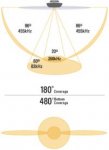Re: single beam fishfinder
Well put Beaufort, couldn't explain it better than that

Well....yes and no. It goes well beyond how big of an area you see. The different frequencies have a dramatic effect on object defintion.
A higher-frequency transducer will put out quicker, shorter, and more frequent sound waves. Like the ripples made when a small pebble is thrown into still water, small waves of sound move evenly out and away from the source. Because they are just small waves, they will not travel far, and small obstacles will cause them to bounce back. Higher frequencies are more sensitive to small objects and will send back detailed information which will show as crisp high-resolution pictures on the screen. The range of high-frequency sound waves, however, is short. Sound waves emitted by a 200 kHz transducer have a limited range of about 600?.
Now, think of the large waves created by a large boulder thrown into still water. Low-frequency sound waves are like these large waves; they travel much farther than high-frequency waves. But because low-frequency waves are so large, they wash right over small obstacles. Low-frequency sound waves are not as sensitive in detecting small fish or other small obstacles as are high-frequency waves, and although they can see to greater depths, they will not send back detailed information or clear crisp pictures.
A group of 3 fish wil most likely show up as 3 distinct marks when using 200kHz. When using the 83 kHz setting, the same 3 fish may just show up as a blob or a single return. Same for objects on the bottom. A rock on the bottom will most likely show up clearly at 200 kHz where as at 83 kHz it might just show up as a bump if anything at all.
Bottom line, 200kHz = Small view of field, great detail and resolution. 83kHz = Larger field of view, less detail, less resolution.
FWIW: Airmar makes a 200kHz transducer with a 38 x 12 degree beam which you can rotate to match the situation. Beats the heck out of using 83kHz just to get the field of view you think you need.

























